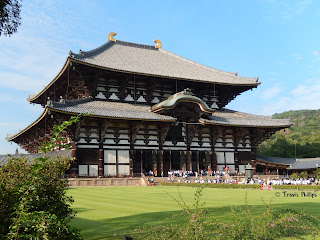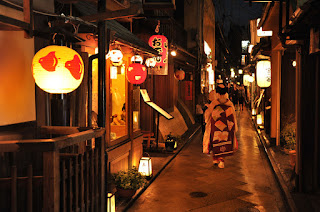Tōdai-ji (東大寺)
 Perhaps one of the main reasons tourists and world travelers alike flock to Nara. This grand
Perhaps one of the main reasons tourists and world travelers alike flock to Nara. This grand Buddhist temple was found in the early 8th century (around 751 AD), and is home to the largest statue of Buddha Vairocana. Measuring in at nearly 15 meters or almost 50 feet, believe me when I say, this statue is HUGE. Pictures really just don't do its size any justice, which is why this temple is an absolute must-see to truly appreciate its magnificence.

As you enter and all throughout the temple, there are several other amazing statues including two of my favourites known as Niō. I like to just call them Gate Guardians as they're typically found protecting the entrances of Buddhist temples. They're often very difficult to photograph as they're hidden behind a mesh screen.
If you're interested in reading more about Todai-ji, click here.
Nara Deer Park
Something you'll come across on your way to Tōdai-ji is the Nara Deer Park. Coming from Canada, we have PLENTY of deer here, but none as docile and friendly as the deer you'll find here. They can actually become quite pesky when they realize you have food, so be careful! In the park, there are some small street vendors who sell I guess what you would call deer crackers/cookies (Shika Senbei)? Basically they're just a hand full of crackers for ¥200 that you can feed to the deer. I have to admit I had a bit of fun with it. After running out, they would sometimes nip at your clothes but don't worry, they're harmless.
Within the deer park there's several paths you can follow leading you around the park along some incredibly beautiful ponds, waterfalls, and even a few pagodas.
Sanjo Dori
After spending a long day exploring Todai-ji and hanging out with the deer, I highly suggest heading over to Sanjo Dori (Street). Here, you'll find plenty of restaurants to refuel at and a ton cool small Japanese stores for souvenirs. The street itself is really interesting, it's brick layered shopping district, with a lot discover. In fact, one of the most famous mochi shops in Japan is located on the corner of Sanjo Dori Street and Mochiido-No-Center-Gai (Map below). If you're lucky and your timings right, you might come across the store Nakatanidou when the Master is preparing a fresh batch of mochi. It's such a cool experience!
A traditional Japanese activity for many families during New Years, the term for this ritual is known as Mochitsuki (餅つき) or "Mochi Pounding" in English. These guys are national champions in Japan and rightly deserve it.
A traditional Japanese activity for many families during New Years, the term for this ritual is known as Mochitsuki (餅つき) or "Mochi Pounding" in English. These guys are national champions in Japan and rightly deserve it.












